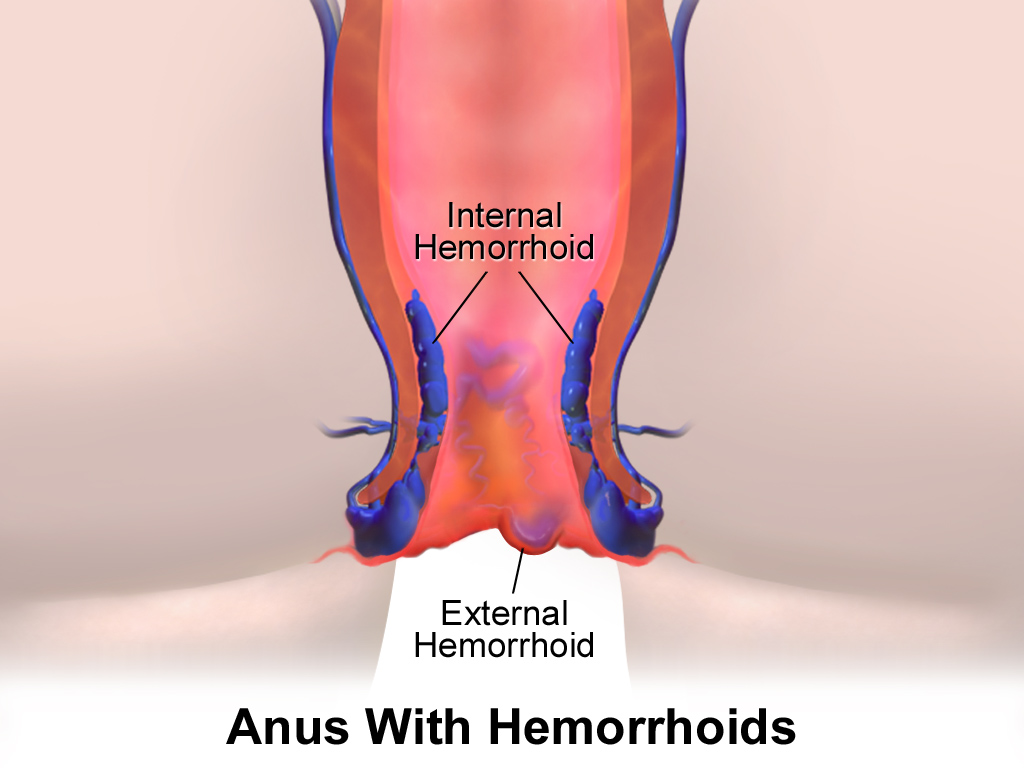Hemorrhoids classification: Difference between revisions
Ahmed Younes (talk | contribs) No edit summary |
m (Bot: Removing from Primary care) |
||
| (11 intermediate revisions by 5 users not shown) | |||
| Line 1: | Line 1: | ||
__NOTOC__ | __NOTOC__ | ||
{{Hemorrhoids}} | {{Hemorrhoids}} | ||
{{CMG}} | {{CMG}}; {{AE}}{{AY}} | ||
==Overview== | ==Overview== | ||
Hemorrhoids can be classified according to their | Hemorrhoids can be classified according to their location as external or internal hemorrhoids. Furthermore, internal hemorrhoids can be graded according to severity into 4 grades. | ||
==Classification== | ==Classification== | ||
Hemorrhoids can be classified according to their | Hemorrhoids can be classified according to their location as external or internal hemorrhoids.<ref name="pmid21825884">{{cite journal |vauthors=Rivadeneira DE, Steele SR, Ternent C, Chalasani S, Buie WD, Rafferty JL |title=Practice parameters for the management of hemorrhoids (revised 2010) |journal=Dis. Colon Rectum |volume=54 |issue=9 |pages=1059–64 |year=2011 |pmid=21825884 |doi=10.1097/DCR.0b013e318225513d |url=}}</ref> | ||
===External hemorrhoids=== | ===External hemorrhoids=== | ||
*External hemorrhoids | |||
* | {| style="float: right; width: 350px;" | ||
*External hemorrhoids are prone to [[thrombosis]] | | [[Image:Blausen 0408 Hemorrhoids.png|right|400px|thumb|By BruceBlaus. When using this image in external sources it can be cited as:Blausen.com staff (2014). "Medical gallery of Blausen Medical 2014". WikiJournal of Medicine 1 (2). DOI:10.15347/wjm/2014.010. ISSN 2002-4436. - Own work, CC BY 3.0, https://commons.wikimedia.org/w/index.php?curid=27924388]] | ||
|} | |||
*External hemorrhoids occur below the dentate line. | |||
*External hemorrhoids are sometimes painful and can be accompanied by [[swelling]] and [[irritation]]. | |||
*[[Itching]], although often thought to be a symptom of external hemorrhoids, is more commonly due to skin [[irritation]]. | |||
*External hemorrhoids are prone to [[thrombosis]]; if the [[vein]] ruptures and a [[blood clot]] develops, the hemorrhoids become [[thrombosed]].<ref>E. Gojlan, ''Pathology, 2nd ed.'' Mosby Elsevier, Rapid Review series.</ref> | |||
===Internal hemorrhoids=== | ===Internal hemorrhoids=== | ||
*Internal hemorrhoids | *Internal hemorrhoids occur above the dentate line. | ||
*As this area lacks | *As this area lacks [[nociceptor|pain receptors]], internal hemorrhoids are usually not painful and most people are not aware that they have them. | ||
*Internal hemorrhoids, however, may bleed when irritated. | *Internal hemorrhoids, however, may bleed when irritated. | ||
*Untreated internal hemorrhoids can lead to two severe forms of hemorrhoids: | *Untreated internal hemorrhoids can lead to two severe forms of hemorrhoids: prolapsed and strangulated hemorrhoids. | ||
====By degree of prolapse==== | ====By degree of prolapse==== | ||
Furthermore, internal hemorrhoids can be graded according to severity into 4 grades. The most common grading system was developed by Banov:<ref name=". <ref> name="pmid3861909">{{cite journal |author=Banov L, Knoepp LF, Erdman LH, Alia RT |title=Management of hemorrhoidal disease |journal=J S C Med Assoc |volume=81 |issue=7 |pages=398–401 |year=1985 |pmid=3861909 |doi=}}</ref> | Furthermore, internal hemorrhoids can be graded according to severity into 4 grades. The most common grading system was developed by Banov:<ref name=". <ref">name="pmid3861909">{{cite journal |author=Banov L, Knoepp LF, Erdman LH, Alia RT |title=Management of hemorrhoidal disease |journal=J S C Med Assoc |volume=81 |issue=7 |pages=398–401 |year=1985 |pmid=3861909 |doi=}}</ref> | ||
* '''Grade I:''' The hemorrhoids do not [[prolapse]]. | |||
* '''Grade II:''' The hemorrhoids [[prolapse]] upon defecation but spontaneously reduce. | |||
* '''Grade III:''' The hemorrhoids [[prolapse]] upon defecation, but must be manually reduced. | |||
* '''Grade IV:''' The hemorrhoids are prolapsed and cannot be manually reduced. | |||
==References== | ==References== | ||
{{Reflist|2}} | {{Reflist|2}} | ||
{{WH}} | |||
{{WS}} | |||
[[Category:Gastroenterology]] | [[Category:Gastroenterology]] | ||
[[Category:Surgery]] | [[Category:Surgery]] | ||
[[Category:Needs overview]] | [[Category:Needs overview]] | ||
Latest revision as of 22:03, 29 July 2020
|
Hemorrhoids Microchapters |
|
Diagnosis |
|---|
|
Treatment |
|
Case Studies |
|
Hemorrhoids classification On the Web |
|
American Roentgen Ray Society Images of Hemorrhoids classification |
|
Risk calculators and risk factors for Hemorrhoids classification |
Editor-In-Chief: C. Michael Gibson, M.S., M.D. [1]; Associate Editor(s)-in-Chief: Ahmed Younes M.B.B.CH [2]
Overview
Hemorrhoids can be classified according to their location as external or internal hemorrhoids. Furthermore, internal hemorrhoids can be graded according to severity into 4 grades.
Classification
Hemorrhoids can be classified according to their location as external or internal hemorrhoids.[1]
External hemorrhoids
 |
- External hemorrhoids occur below the dentate line.
- External hemorrhoids are sometimes painful and can be accompanied by swelling and irritation.
- Itching, although often thought to be a symptom of external hemorrhoids, is more commonly due to skin irritation.
- External hemorrhoids are prone to thrombosis; if the vein ruptures and a blood clot develops, the hemorrhoids become thrombosed.[2]
Internal hemorrhoids
- Internal hemorrhoids occur above the dentate line.
- As this area lacks pain receptors, internal hemorrhoids are usually not painful and most people are not aware that they have them.
- Internal hemorrhoids, however, may bleed when irritated.
- Untreated internal hemorrhoids can lead to two severe forms of hemorrhoids: prolapsed and strangulated hemorrhoids.
By degree of prolapse
Furthermore, internal hemorrhoids can be graded according to severity into 4 grades. The most common grading system was developed by Banov:[3]
- Grade I: The hemorrhoids do not prolapse.
- Grade II: The hemorrhoids prolapse upon defecation but spontaneously reduce.
- Grade III: The hemorrhoids prolapse upon defecation, but must be manually reduced.
- Grade IV: The hemorrhoids are prolapsed and cannot be manually reduced.
References
- ↑ Rivadeneira DE, Steele SR, Ternent C, Chalasani S, Buie WD, Rafferty JL (2011). "Practice parameters for the management of hemorrhoids (revised 2010)". Dis. Colon Rectum. 54 (9): 1059–64. doi:10.1097/DCR.0b013e318225513d. PMID 21825884.
- ↑ E. Gojlan, Pathology, 2nd ed. Mosby Elsevier, Rapid Review series.
- ↑ name="pmid3861909">Banov L, Knoepp LF, Erdman LH, Alia RT (1985). "Management of hemorrhoidal disease". J S C Med Assoc. 81 (7): 398–401. PMID 3861909.